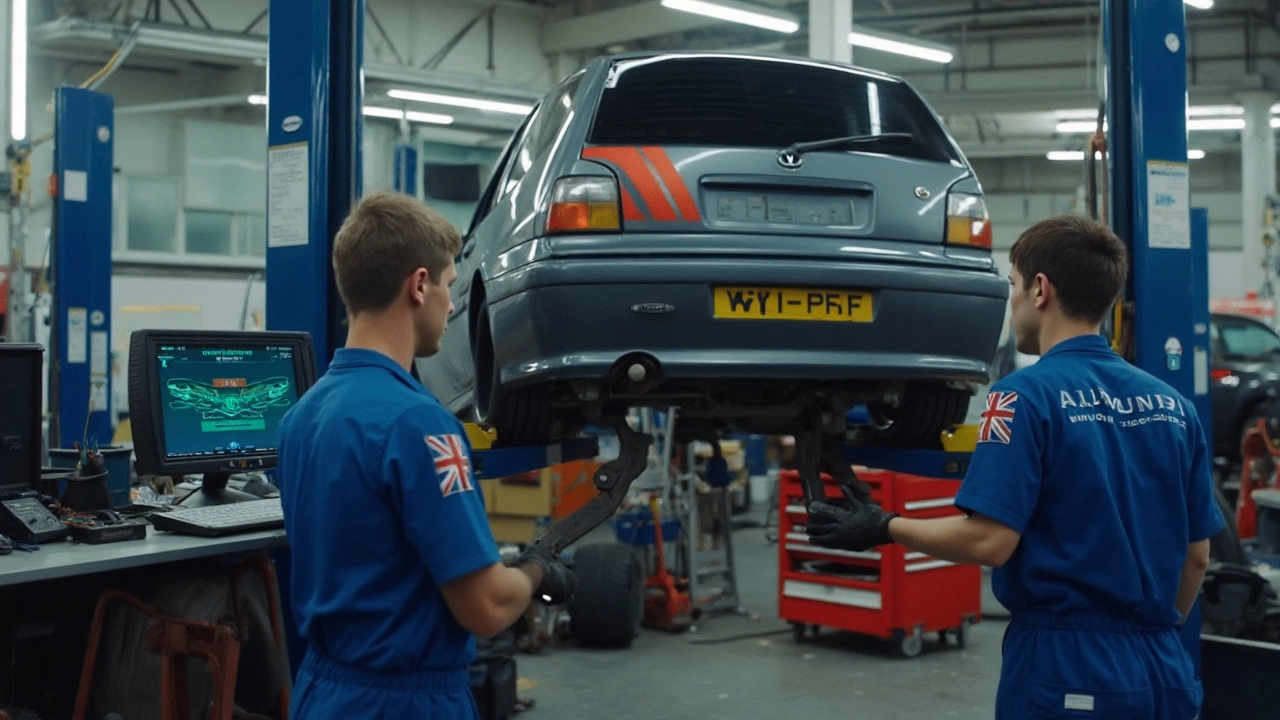The idea of dropping your car a few inches with aftermarket lowering springs is tempting. That aggressive stance? It looks sharp, no doubt. But a lower ride doesn’t come without its quirks and downsides—some of them show up fast, others bite you down the road. If you’re thinking it’s just about looking cool, buckle up. There’s more to it; the trade-offs are real, and they can mess with how you drive every day.
Let’s not sugarcoat it. Lowering springs change how your car rides, handles, and even how long simple parts last. Yeah, you might hug corners better, but that comfort you’re used to? Say goodbye—it's going to get firmer and sometimes downright harsh. And that’s before you even meet the potholes and steep driveways just waiting to scrape your bumper or rip up your undercarriage.
- Good Looks, But at What Cost?
- How Ride Comfort Takes a Hit
- Handling: Not Always an Upgrade
- Tire Wear and Alignment Woes
- Longevity of Suspension Components
- Legal and Everyday Hassles
Good Looks, But at What Cost?
There’s no question—a lowered car with lowering springs turns heads. That stylish, hunkered-down look is the main reason most people go for it. But chasing looks isn’t free, and I’m not talking about the price of the springs. Once you go low, you’re signing up for a bunch of trade-offs every time you get behind the wheel.
You’ll notice right away that clearance drops, sometimes by as much as 2 inches. Everyday stuff like steep driveways, speed bumps, and even potholes become minefields. A stock sedan, for example, usually has about 6 inches of ground clearance. Drop it to 4, and suddenly you’re scraping on things you never even noticed before. It’s not just cosmetic—the risk of undercarriage, oil pan, and bumper damage shoots up.
| Stock Ground Clearance (inches) | After Lowering (inches) |
|---|---|
| 6.0 | 4.0 |
| 5.5 | 3.5 |
Losing clearance isn’t just annoying. If you live somewhere with rough roads or lots of snow, you’re probably asking for trouble. Curb ramps, road debris, or even just getting tow truck service can get tricky. Also, a low ride height makes jacking up the car for tire changes a pain.
If you think a clean stance equals a smooth ride, brace yourself. As car handling expert Matt Farah puts it,
“Lowering springs can easily turn a practical daily driver into a car that bottoms out over every dip and feels crashy on the street.”Aggressive looks cost you comfort—and sometimes, your own patience.
So, sure, lowering is a style flex, but it brings a bunch of daily headaches along for the ride. Don’t expect everyone in your family to appreciate climbing in and out of a low car either. Kids and older folks might find it more of a hassle than anything special.
How Ride Comfort Takes a Hit
Installing lowering springs usually makes your car ride firmer—sometimes a whole lot firmer than stock. The reason? Most lowering springs are stiffer than what came on your car from the factory. Stiffer springs mean your suspension doesn't soak up bumps as well. So that smooth cruise you’re used to over rough city streets? It turns into feeling every pothole, bump, and road seam.
Here’s the thing: With less travel in the suspension, there’s just not as much room for your shocks and springs to absorb impacts. The car sits closer to the ground, and every big dip or speed bump suddenly feels way more dramatic. It’s not just your imagination. It’s basic physics.
A well-known review from Car and Driver summed it up:
"Lowering a car almost always means the ride gets stiffer and less forgiving—think racetrack levels of feedback, just on regular roads."
Plus, not all lowering springs play nice with your stock shocks. When you put stiffer springs on old or worn shocks, you’re probably asking for even more bouncing or, worse, having the shocks fail early.
- Lowering springs + stock shocks can make the ride rougher.
- Some luxury cars lose their plushness completely with cheaper springs.
- If you live in areas with bad roads, expect more shaking, rattling, and maybe even extra trips to the chiropractor.
And here’s a quick data snapshot for context:
| Spring Drop | Reported Comfort Loss* |
|---|---|
| 1 inch | Minimal to moderate |
| 1.5-2 inches | Noticeably harsher |
| 2+ inches | Severe—some report daily discomfort |
*Based on forum user surveys and owner reports
Bottom line: if daily comfort matters, lowering springs might be a trade-off you’ll feel every time you start your commute.
Handling: Not Always an Upgrade
It’s easy to assume dropping your car on lowering springs will turn every corner into a race track experience. In reality, it’s not guaranteed. While lowering can push the center of gravity down, helping some cars feel more planted, it can backfire if not matched with the right shocks, alignment, and even tire choices. Go too low, or pick the wrong springs, and you might notice more bouncing or unpredictable reactions in corners—far from that go-kart feel everyone talks about online.
Factory suspension is balanced for a reason. Lowering can throw off that balance, and if you don’t upgrade your dampers, you risk a floaty ride or even bottoming out. Cars not designed for aggressive lowering can lose suspension travel. Not enough travel means when you hit bumps during a quick turn, tires might not stay fully planted, which kills grip just when you want it most.
There's also the issue of alignment. Drop your car, and your wheels likely fall out of spec. If you’re lucky, that means more negative camber—great for grip, but it can also eat through your tires and make the handling feel twitchy until you get to an alignment shop. Worse, if you don’t fix it, your steering response can get sluggish, or your car might want to pull to one side.
Take a look at how lowering affects basic handling characteristics:
| Modification | Typical Impact on Handling |
|---|---|
| Lowering Springs Only | Reduces body roll, but can stiffen ride and reduce suspension travel |
| Springs + Dampers | More balanced, better control, maintains grip if properly matched |
| Lowered Without Alignment | Can lead to unpredictable handling, excessive tire wear |
The bottom line? Not every car—or every set of lowering springs—delivers real-world, everyday handling upgrades. Unless you plan your setup, match the parts, and iron out the details, you might trade too much comfort and control for the sake of looks.

Tire Wear and Alignment Woes
Here’s where things get real with lowering springs: your tires and alignment often take the brunt of the change. Right out of the gate, dropping your car changes how the wheels sit on the road. If you don’t dial in the alignment after lowering, you’ll almost always end up with what’s called “negative camber”—the tops of the wheels tilt in. This setup looks sporty, but it means more of your tire’s inside edge is hitting the pavement. You end up wearing out the inner tread way faster than the rest, which can cut tire life in half—or worse.
Even with a proper alignment, some cars just can’t be brought fully back to factory spec after a big drop. That’s why you’ll see guys with brand-new tires blowing through sets in only 10,000 miles. And if you skip the alignment? Expect unpredictable handling and even more rapid wear. It’s not just about looks; it’s your grip, braking, and safety at stake.
This might surprise you, but according to tire shops, a car that’s been lowered by two inches or more can end up costing owners an extra 30-50% every year in tire replacement costs, mostly due to uneven wear patterns.
| Modification | Average Tire Lifespan | Common Wear Pattern |
|---|---|---|
| Stock Ride Height | 30,000–40,000 miles | Even |
| Lowered (2+ inches) | 10,000–15,000 miles | Inner edge wear |
Another issue is messed-up toe and caster angles. Messed-up toe means your wheels point slightly in or out, dragging the tires sideways as you roll. Your fuel economy drops, the steering can feel twitchy, and the tires get chewed up even faster. Most regular tire shops won’t touch a slammed car, either—they can’t get their equipment on the wheels or lift the car without scraping something.
If you’re set on dropping your car, do this: schedule a four-wheel alignment immediately after installing lowering springs. And if the shop says the car’s out of their alignment range, ask about adjustable arms or camber kits. Skipping these steps is the fastest way to waste cash on tires.
Longevity of Suspension Components
Switching over to lowering springs isn’t just a simple bolt-on—your whole suspension system feels the difference over time. The stock shocks and struts that came with your car are tuned for the original ride height. Once you lower it, those parts end up working harder than they’re supposed to. The stiffer and shorter springs mean they hit the bump stops more often and bottom out on big dips or potholes. It’s not just talk; automotive shops see premature shock and strut failures all the time after a lowering job.
Here’s what tends to happen when you lower a car:
- Shocks and struts wear out faster. They’re made for the stock springs, and lower springs usually mean less travel and more stress every time you hit a bump.
- Ball joints and bushings give out sooner. They’re forced to operate at angles that the factory never intended, which puts extra load and leads to early failure.
- Suspension noise goes up. You might hear more rattling or clunks from components that are under extra strain or misaligned.
One survey of independent mechanics found that cars with aftermarket lowering setups needed shock or strut replacements up to 30% earlier than stock. Here’s a quick look at some typical lifespans:
| Component | Stock Lifespan (miles) | With Lowering Springs (miles) |
|---|---|---|
| Shocks/Struts | 60,000–90,000 | 40,000–60,000 |
| Bushings | 80,000+ | 50,000–70,000 |
| Ball Joints | 70,000–100,000 | 50,000–70,000 |
Treat lowering springs as a performance upgrade that comes with hidden costs. If you want to lower your car, go for springs that are designed to work with high-quality aftermarket shocks and struts. Skimp here, and you’ll be back under the car, swapping out worn parts way sooner than you’d planned.
Legal and Everyday Hassles
So you’ve dropped your ride with lowering springs, and it looks mean—until you get pulled over or can’t clear your own driveway. Dropping a car isn’t always legal, and the rules change depending on where you live. For example, in California, cops can ticket you if any part of your car sits lower than the bottom edge of your wheels. That’s called the "scrub line" law, and it trips up a lot of folks who didn’t do their homework.
It’s not just about tickets, either. Many states have specific minimum ground clearance laws—often around four inches. Some cities even have rules against modifying suspension altogether. If you skip the research, you might end up with a car you can’t even legally drive on local roads.
Daily life with a lowered car isn’t always a joy, either. Parking lot entrances, speed bumps, and steep driveways become actual obstacles. Forget about hauling extra passengers or heavy cargo, since with less clearance, your car can scrape the pavement easier than you think. And while the stance crowd laughs it off, nobody’s happy when you crack your oil pan or bend an exhaust pipe.
Insurance headaches? They’re real. Many insurers need you to declare any lowering springs or suspension mods. Hide it and have an accident, and some companies can refuse your claim, especially if they think the mod played a role. You’ll also need to tell your mechanic—some shops charge extra to work on lowered vehicles because it’s harder to get them on lifts without damage.
| State | Minimum Ground Clearance | Penalty for Violation |
|---|---|---|
| California | 4 inches (scrub line law) | $197 fine |
| Texas | No specific law, judged on safety | Possible inspection failure |
| New York | 3 inches | $150 fine |
Bottom line: swapping in lowering springs can come with a ton of small daily hassles and a decent risk of getting on the wrong side of the law. Not fun when your quest for the perfect stance ends with you stranded or fined.




